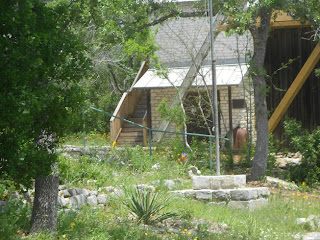When you're looking for that unique historic out of the way stop while searching for things to do in Austin Texas, a visit to the old Anderson Mill is just the place.
 |
| Anderson Mill, TX |
Anderson Mill came into being during the American Civil War days when a mill was set up to help make gunpowder for the Confederate Army. The Mill had been named the Travis Powder Company in 1863. The Anderson Mill was set up by a man named Thomas Anderson and his two sons on Cypress Creek in northwestern Travis County Texas. Anderson had moved to Texas from Virginia during the 1850's. While the mill was important for the Confederacy during the war, the mill was turned into a gristmill when the war ended. At one point Anderson added a cotton gin to the operation. Thomas Anderson also became a postmaster when the first post office opened in 1876.
At the beginning of the Civil War gunpowder supplies for the Confederate armies were insufficient. In 1861 Jefferson Davis, president of the Confederacy, charged Colonel George Washington Rains with solving this issue by creating a local supply of gunpowder. It was just this need that turned small mills such as Anderson's Mill into a war supply center. These local gunpowder mills could be found throughout the Confederacy. The largest by far of these gunpowder factories was the Confederate Powder Works consisting of some twenty-six buildings in Augusta Georgia.
 |
| Restored Anderson Mill structure |
During the Civil War years, Anderson and others extracted saltpeter from bat guano available from nearby caves. They combined it with charcoal which was obtained by burning cedar trees along with sulfur to produce the all important gunpowder for the Confederacy. Soldiers during the Civil War also used bat guano from Longhorn Cavern near Burnet Texas also in the Hill Country region to manufacture gunpowder in the limestone cave’s main room.
The Disappearance of the Water Powered Mill
As with water powered gristmills which accounted for almost all of them, the entire industry became more mechanized and the water powered mills disappeared. By the early 1900s, most of these labor intensive mills and their grain grinding stones were replaced by electric power and high-speed steel rollers. To give you an idea of the smallness of the community, in the year 1884 there were only thirty people residing at Anderson Mill. Interestingly enough, while stone milling became increasingly rare there is a renewed appreciation for this old process. Today as you travel around the U.S. you'll find restored gristmills that have been turned into commercial ventures or in some cases serve as museums.
 |
| Texas Hill Country view from Anderson Mill |
The Anderson Mill site was given a Texas State Historical Marker in 1936, and the ruins of the mill were actually dismantled in 1941. This was prior to the building of the Mansfield Dam which itself created present day Lake Travis. The Anderson Mill Gardeners together with family members to built a replica of the mill and museum on land near the original site.
According to Anderson Mills Gardeners, Inc "The Anderson grist mill was a gathering place for farmers who came to have corn ground. The settlers had to travel many miles and usually several wagons from a community would come to the mill and camp while their corn was being ground. The camping was enjoyed by all because this was a period of telling the news and helping each other with problems. The miller could only grind forty bushels of corn a day, so the men who were not helping would be doing repairs or talking about the crops. The women in the mean time were busy cooking and sewing and gossiping."
 |
| Anderson Mill Texas Historic Marker |
Gruene Texas on the Old San Antonio Stage Line
The Guenther House and Pioneer Flour Mill
Today's Anderson Mill
The Anderson Mill and museum are only opened for the public on the fourth Sunday of every month between March and October. The address is 13641 Farm to Market Rd. 2769, Austin, TX.
The mill and museum site is about an eighteen mile drive north from downtown Austin Texas. It is on the north shore of Lake Travis.
For more information regarding scheduled events at the Anderson Mill and museum, see website www.volente.org/amgc/
(Photos from author's collection)
View Larger Map

